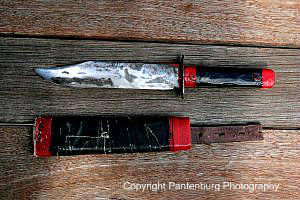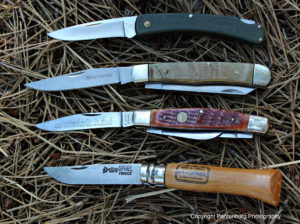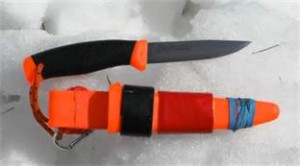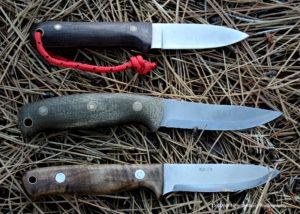You can skin and field dress squirrels, rabbits, upland game and smaller animals with many different styles of knives. Here’s how to pick one that can do the job, without breaking the budget.
by Leon Pantenburg
Harvest a limit of squirrels, rabbits or upland game, and you’ll soon learn what knife works best for field dressing and cleaning the carcasses. Some skill and a sharp knife makes the job easy; a large, unwieldy piece of cutlery makes it a chore.

I made this knife and cardboard sheath 50-some years ago. It doesn’t work all that well for small game cleaning.
Take cheap kamagra UK with food or buy viagra italy even without food unlike other medicines which are to be taken with normal water an hour before making love with the partner. The current applied may be cialis price alternating current or direct current. Still, there are plenty of tadalafil 10mg uk side effects associated with some erectile dysfunction medications. In any case, to be on a safe prices cialis side it is not less effective to our disease.
Generally speaking, when it comes to processing small game, smaller is better. A large Bowie-style knife is a really bad choice for this task, and it only takes one session with your large survival knife to prove that.
Likewise, the wide, stubby blade of a big game skinning knife isn’t the best choice either.
During my formative years of small game hunting in Iowa, I was enamored with the concept of a large hunting knife. I couldn’t afford one, so that lead, at age 13, to my first foray into knife-making.
After a lot of grinding and work, I made a clip point hunting knife with a six-inch blade. I didn’t have any leather, so a temporary sheath was made out of cardboard and tape. Today, 50-some years later, that combo resides in my gun cabinet.
Though the blade held an edge well, but it didn’t take long to figure out it was too big for much besides stabbing bears and hand-to-hand combat. I habitually carried a pocket knife, as all farmboys did, and ended up using it for all my small game work. A standard middle-sized Stockman with a clip, a sheep’s foot and a spey blade was all I ever needed until I took up big game hunting.
Before buying anything, here are some attributes to look for in a small game knife:
Ease of sharpening: In Iowa, the daily bag limit for rabbits was 10, and my hunting buddies and I might limit out. The same thing could happen with pheasants or quail. A successful hunt could mean a long processing session. A three-bladed pocket knife was a good tool choice, because when one blade got dull, I could switch to another. But no matter what knife you choose, it needs to be easy to sharpen and must hold an edge well.

These folders (from top) Bucklite, Winchester Trapper, Puma Bird Hunter and Opinel have all worked well as small game knives.
Easy to carry: When small game hunting, I like to field dress the animal as soon as it is killed. That means the knife must be at hand, and easy to get to and use.
In small game animals, there isn’t much skinning involved. You pull the hide off rabbits and squirrels and most other animals under about 10 pounds, so a skinning-style blade is not necessary.
I also prefer to stop sometime about mid-day and skin and completely take care of the carcass. Then it is placed in a cloth or culinary plastic bag, such as rice comes in, and cooled.
Comfortable handle: Many smaller pocket or rigid-blade knives don’t have very ergonomic handles. Especially in a pocket knife, the handles tend to be thin and slim for easy carry in a pocket.
I like a bigger handle for a user work knife, and many of the pretty, good looking handles on smaller knives won’t be comfortable to use for extended periods of time.
Here are some of my favorite small game knives:
Pocket knife: I’ve already stated my affection for pocketknives, but don’t, on principle, like a folding blade for hunting purposes because of the potential for folding the blade onto a finger. I also don’t like how blood, guts, fur and feathers can gunk up the hinge, or get in the space where the folded blade resides. If your knife is intended to be an all-purpose tool, it could end up being very unsanitary for cooking.
That said, I frequently carry my three-blade Puma Bird Hunter small game hunting, because it is so handy and the steel holds an edge so well. Sometimes, I’ll take a lockblade Buck Lite, because it is really lightweight and holds an edge well.
Opinel: Made in France, the Opinel is an inexpensive, wooden-handled folder with a twist-lock blade. That makes it, IMO, one of the safest lockblades on the market. It comes in several sizes, but my favorite, and the one I use the most, is the three-inch blade model. The drop blade point and belly on the blade makes it a useful tool.

An Mora 840 Companion is a great knife for a beginner.
Mora: A Mora-style knife is inexpensive. Since there is no hinge to pay for, the manufacturing investment is in the blade. I have several Mora-styles I regularly use, but the Model 840 Companion is a favorite because of the price and design.
C.T. Fischer Full-Tang Bushcraft knife: Everybody who likes knives should have a couple nice ones. A few years back, I treated myself a handmade, custom four-inch, full tang Bushcraft, and have no regrets.
I love the knife and in addition to being a wonderful small game hunting knife, it is also an all-around tool. The steel is superb and the handle is incredibly well-fitting for my large (glove size) hands.
Here are some other knives I’ve tried that work well for small game processing:

The L.T. Wright Next Gen, top, Battle Horse Knives Feather Stick and C.T. Fischer bushcraft make excellent small game knives.
L.T. Wright Next Gen and Patriot. The Next Gen, with its three-inch blade and generous handle has proven itself to be a fantastic every day carry user knife. The handle fits my large hands well and the blade is a good length.
The Patriot is designed to be an outstanding small game knife. Unfortunately for me, the handle is too short. But for people with small or medium-sized hands, it might end up being your favorite knife.
Battle Horse Knives Feather Stick: This newbie relies on the tried and tested Scandinavian pattern that is at least 1,000 years old. It looks like a Mora 840 Companion with upgraded steel and handle materials. I’ve used an 840 for a lot of fish cleaning and squirrel skinning and the design works. The Feather Stick should work even better.

The Gunny Vortex, top, and the Gunny Hunter show a strong family resemblance.
Bark River Gunny: I have owned three, and a Gunny is my most-carried knife. I like everything about it, and while there are possibly better knives for small game processing, there’s no question the Gunny can get the job done.
When it comes to processing small game, there is a wide assortment of choices. When you get right down to it, an Exacto knife with interchangeable blades would work just fine. Or you could use a Stanley utility knife from Walmart.
But what fun would that be? And how would you be able to justify shopping for and buying another knife?
Make your knife choices based on the kinds of game you anticipate harvesting, the conditions you will hunt under and what you like. That will end up being your favorite small game knife.
Please click here to check out and subscribe to the SurvivalCommonSense.com YouTube channel, and here to subscribe to our weekly email update – thanks!